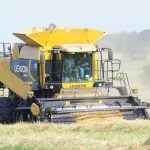Much like humans who must make their bed everyday, certain bees within a colony are compelled to maintain a neat and tidy hive.
While a clean home has value, having a hygienic hive can be a matter of life or death for bees because diseases can infest and destroy messy colonies.
“Hygienic behaviour is typically associated with the removal of dead or diseased brood: larvae and pupae that are dead or dying,” said Stephen Pernal, an Agriculture Canada apiculturist in Beaverlodge, Alta.
“What this does, this breaks the disease cycle … to prevent the (disease) from proliferating in colonies.”
Read Also
U.S. regulator aims to allow dicamba use with safeguards
WASHINGTON, Sept 19 (Reuters) – The U.S. Environmental Protection Agency is aiming to allow farmers to spray the controversial weed-killer…
The difficulty, though, is how to select and breed bees that are tidy.
Since it’s not possible to determine if a bee has a six year old jar of mustard in its fridge, Pernal and scientists with Alberta Agriculture, the University of Manitoba and the University of British Columbia have developed a novel approach to solve this breeding conundrum.
“What we’re trying to do is develop a tool that beekeepers, who breed their own bees, can use to advance the speed and speficificity in which they can make gains in their stock for selection,” Pernal said.
In particular, Pernal and his colleagues are trying to establish a link between specific proteins in bees and hygienic behaviour. Genes contain the instructions to make molecules known as proteins, which play a critical role in cell functions.
“In this case … we’re not looking at the genetics of a colony, per se, but what primary thing those (genes) produce, which are proteins,” Pernal said.
“In colonies that are disease resistant, they produce a lot of this protein or don’t produce a lot of this protein. If we can make a quick test for (the protein), the beekeeper can use (it).”
Establishing a link between a particular protein and good hive hygiene is significant because varroa mites and diseases such as nosema kill thousands of bee colonies in Canada each year.
The ability to use protein markers to select bees that are hygienic and naturally resistant to disease might save millions of bees and reduce beekeepers’ dependence on antibiotics and miticides to protect hives.
That is why Genome B.C., Genome Canada, Genome Alberta and the B.C. Honey Producers Association are funding the $5.7 million project.
“The tools being developed in this project are expected to be less susceptible to evolutionary resistance and the development timeline should be less than traditional pesticides,” said Leonard Foster, a UBC professor of biochemistry and molecular biology and one of the lead scientists in the project.
Good hygiene, in turns out, is an inheritable trait in bees. However, the characteristic varies from family to family within a colony.
“Within a colony, you have many different sub-families or worker bees, because the queen mates with many drones, or males,” Pernal said.
“So if the majority of the workers express that hygiene trait, the colony, overall, will be a hygienic colony.”
Pernal and his colleagues are conducting tests to validate their theory that particular proteins are related to hygienic behaviour in bees.
Over the last couple of years, Pernal and his colleagues have frozen patches of brood within bee colonies. They quantify good hygiene by measuring how much frozen material the bees remove from the hive in a certain period of time.
“We freeze a patch of brood with liquid nitrogen, we kill it. Then what we do is evaluate … how many of those frozen, killed pupae are removed.”
After conducting several tests and breeding two generations of bees based on protein markers, the results have demonstrated it is possible to select bees that are more hygienic.
“We’ve enriched the level of hygienic behaviour,” by using the markers, said Pernal, who is encouraged by the results.
Pernal said the ultimate goal of the three year project, which concludes in March 2014, is to develop a test to help beekeepers select bees that are more hygienic based on levels of a specific protein.
If successful, it may allow apiarists to produce a population of bees that are more resistant to disease and possibly mites, he said.
“Some people would suggest that selecting (bees) strongly for hygienic behaviour also may (increase) resistance to varroa mites,” he said.
“So we’re also carefully gauging how the gains in disease resistance and resistance to varroa mites are advancing with each generation (of bees).”
Researchers at Purdue University announced in early November that they had identified a group of genes connected to hygienic behaviour in bees.
The finding was significant, but it’s not known if the Canadian protein marker approach or the gene method offers the best path to breeding hygienic and healthy bees, Foster said.
“Until these reports from (Purdue), no one had been successful in accurately identifying genes that might be involved in hygienic behaviors,” he said in an e-mail. “(However) genes can only effect function by providing the instructions for making a protein…. For this reason, it’s equally valid to look at either (approach).”
What are proteins?
Proteins are large molecules made up of amino acids linked like a chain. The amino acids can combine in different ways to form tens of thousands of proteins. For example, the human body contains more than two million proteins, which regulate cell reproduction, transport oxygen and defend the body against disease.
Scientists can use protein expression, or biomarkers, to associate proteins with specific diseases. For instance, prostate specific antigen levels are used to diagnose prostate cancer in men.
Source: American Medical Association









